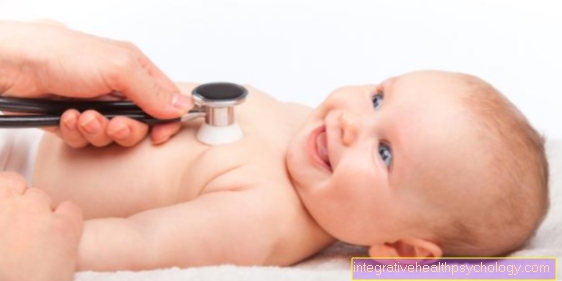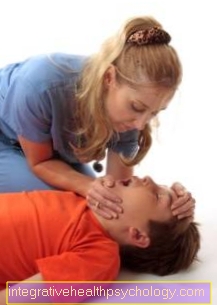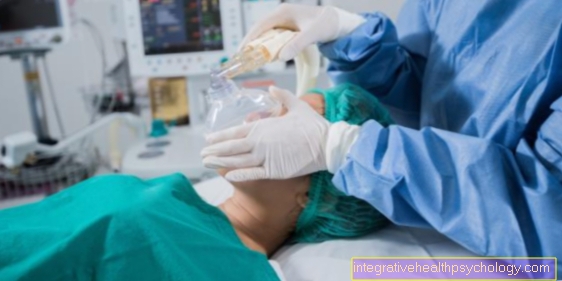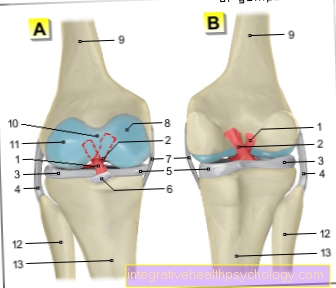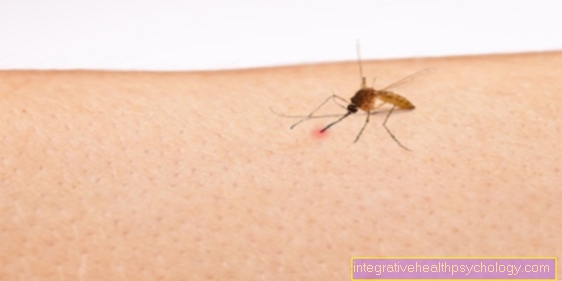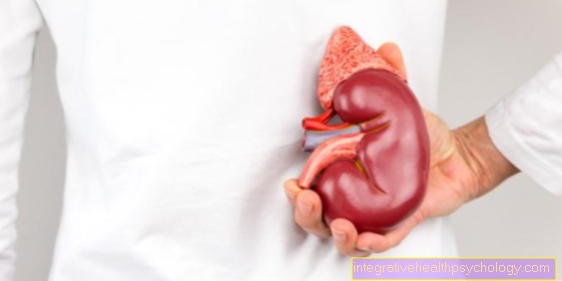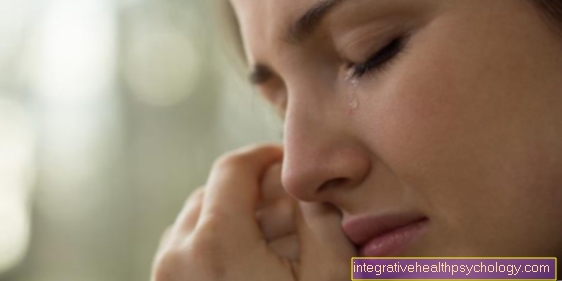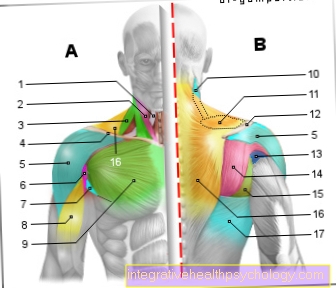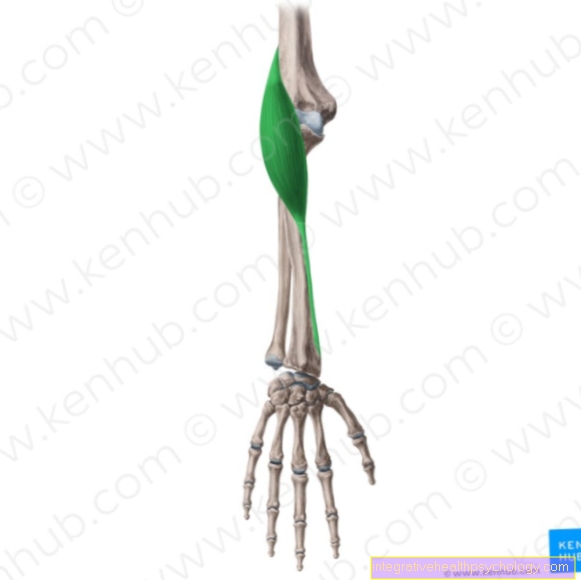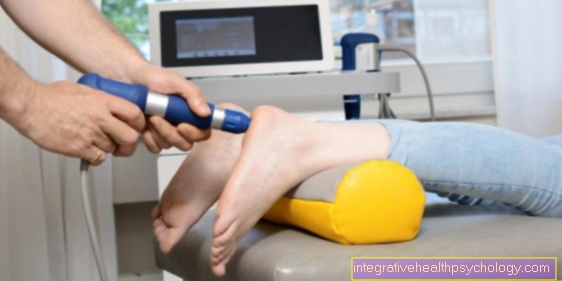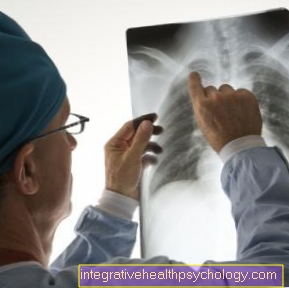poliomyelitis
Synonyms
Poliomyelitis, polio
English: poliomyelitis
introduction
Polio (poliomyelitis, „polio“) Is an infectious disease that is one of the so-called childhood diseases. It is caused by polioviruses. In the unvaccinated, these can cause symptoms of paralysis due to the involvement of muscle-controlling nerve cells in the spinal cord. The clinical picture can vary widely and range from mild or symptom-free clinical pictures to pronounced paralysis.
Also read: vaccination

Occurrence and frequency
The transfer of the Poliovirus takes place fecal-oral and is highly contagious. 90-95% of infections are completely symptom-free. Since the vaccine was one of the vaccinations recommended by STIKO within the first year of life, polio epidemics have largely decreased. Only in developing countries do polio cases continue to occur more frequently. The incubation period is 1-2 weeks.
causes
After infection with the virus, it multiplies on a massive scale. This is mainly done in Epithelia, the lymph tissue of the pharynx and in the Intestines. When the virus gets through the Blood-brain barrier reaches the central nervous system, it mainly affects the gray ("polio") substance of the spinal cord. This is where the motor anterior horn cells lie and then lead to the clinical manifestation of the infection.
The poliovirus
The poliovirus comes from the enterovirus family (intestinal viruses). It is very contagious and is mainly found in stool and bronchial secretions. The infection occurs faecal-oral or via droplet infection.
In areas where the poliovirus can still be found due to insufficient vaccination rates (Afghanistan and Pakistan), it leads to outbreaks of epidemics due to the high level of contagiousness (infection rate).
The only preventive measure against the poliovirus is a dead vaccine. The dead vaccine leads to immunity through active immunization.
Read more on the topic: Vaccination against polio
Symptoms
The symptoms of polio are divided into different stages.
- Minor illness: This manifests itself in non-specific symptoms such as fever, fatigue, sore throat, vomiting and diarrhea. The symptoms usually persist for 3 to 5 days and in most cases the disease is over afterwards.
- Major illness (non-paralytic poliomyelitis): After a latency period of approx. 1 week, meningism symptoms occur in 5-10% of cases. These include fever around 39 ° C, stiff neck, CSF pleocytosis and headache.
- Paralytic poliomyelitis: This form of the disease occurs in 1% of cases and often leads to a characteristic double-peaked fever curve. This is usually accompanied by severe pain, flaccid paralysis and weakness. In some cases, vegetative symptoms such as tachycardia, hypertension and sweating can also occur. Since the paralysis can also affect the diaphragm, patients become inadequate breathing. There are no loss of sensitivity with polio.
- Bulbar poliomyelitis: This form of the disease is characterized by high fever, cranial nerve paralysis and difficulty swallowing. There is also central respiratory paralysis, which makes intubation and artificial ventilation necessary.
- Postpoliomyelitis Syndrome: This syndrome is very common. Renewed pain and muscle wasting 10-30 years after the primary infection are typical. The symptoms can appear in the previously affected regions or in muscle regions that have not yet been affected.
Diagnosis
The viruses can be found in the stool, or from the saliva Liquor be detected. The corresponding antibodies are also found in the serum.
therapy
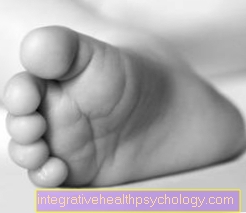
There is no possibility of drug therapy. That is why there is above all an intensive care and bed rest as well physical therapy in the foreground. Analgesics and Anti-inflammatory drugs can be used to relieve symptoms. If there is a risk of a threatening form of polio, the patient should be admitted to the hospital and closely monitored.
How is polio transmitted?
The poliovirus is excreted during the illness. It is mainly found in the stool and bronchial secretions. The infection therefore mostly occurs fecal-oral (on door handles of toilets) or above Droplet infection. It is therefore important to wash your hands thoroughly with soap after using the toilet. This also prevents infection with other pathogens. The droplet infection usually occurs through the sneezing of infected people, using the same dishes or glass and coming into contact with the saliva of an infected person.
How high is the risk of infection?
Due to the high vaccination rate, the poliovirus hardly occurs in Germany any more. It's exterminated. Therefore, the infection rate in Germany is very low.
However, for a person who has not been vaccinated, the infection rate is very high in countries where the poliovirus can still be found. These countries are mainly Afghanistan and Pakistan. The infection spreads quickly and can lead to epidemics.
Poor hygienic conditions make the transmission even more likely. The pathogen can also be found in water if it has been contaminated with faeces. The transmission can lead to infection both when washing and when drinking the contaminated water. Children of primary school age are particularly affected.
Consequences of polio
In most cases, polio runs with flu-like symptoms and heals without consequences. In approximately 1-2% However, of the cases it can lead to one Involvement of the nervous system come. This usually leads to paralysis of the lower extremities (legs) first. It can also lead to paralysis of other parts of the body.
in the worst case is the Brain stem affected by the disease. The breathing center and the circulatory regulation center are located in the brain stem. Thus, through the involvement of the brain stem, it comes to Respiratory and circulatory regulation disorderswhich leads to death in the disease.
Another consequence of poliomyelitis is that Post Poliomyelitis Syndrome (PPS). This leads to pain and slackening of the muscles in different parts of the body. This consequence only occurs 10 to 30 years after infection. The disease is to be taken very seriously and can end in a wheelchair or even fatally.
Vaccination against polio
Poliomyelitis is caused by an infection with the poliovirus. There is a vaccination against the poliovirus.
This vaccination is a dead vaccine and contains inactivated parts of the poliovirus. According to the STIKO (permanent vaccination committee of the Robert Koch Institute), basic immunization is required after the second month of life, the third month of life and the fourth month of life, and after eleven to fourteen months of life.
Afterwards, a booster vaccination is recommended between the ages of 9 and 17 years. When traveling to countries where the vaccination rate against the poliovirus is not yet very high, a booster vaccination in adulthood is recommended.
The vaccination is well tolerated and in rare cases it can lead to vaccination or allergic reactions. Vaccine reactions include reddening of the puncture site or muscle pain and fever. Allergic reactions are extremely rare. A vaccination against the poliovirus is recommended.
You can find out more about the topic here: Vaccination against polio
Can Polio Cure?
There is no cure for polio.
In 98% of the cases, the infection proceeds like a flu-like infection without affecting the central nervous system.
If the central nervous system is affected, a cure is not possible. The disease then leads to paralysis of the muscles, which can extend to the respiratory muscles. If this is the case, the disease has a fatal outcome. The only measure that is used preventively against polio is therefore vaccination against the poliovirus.
Read more about the topic here: Vaccination against polio
Summary
The poliomyelitis can be a very dangerous disease caused by a RNA virus the group of Enteroviruses is caused. Due to the high vaccination coverage, polio has become very rare in Germany. Nevertheless, if possible, all children should be vaccinated according to the guidelines, as the virus continues to occur frequently, especially in developing countries. The symptoms can vary widely and range from having mild viral infection symptoms fever and exhaustion up to the severest paralysis. Paralysis of the diaphragm and the central respiratory center is particularly dangerous and life-threatening, which makes mechanical ventilation essential. In addition, the after-effects of paralysis can last a lifetime. Neurological abnormalities and deficits can also persist for life. The worst complication is death from respiratory failure. For this reason, adequate intensive care treatment is necessary if complications are suspected.
more information on this topic
- Vaccination against polio
- Vaccinations for adults
- Vaccinations for babies
Here you can get more information:
- Infantile cerebral palsy
- Paediatrics


